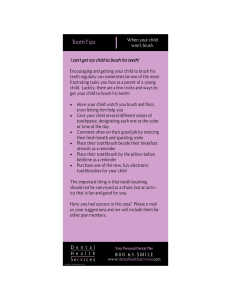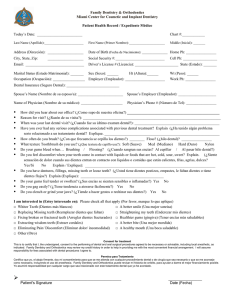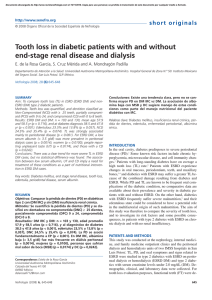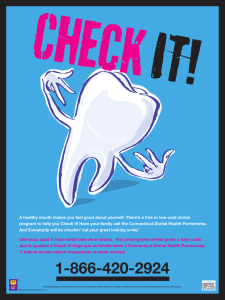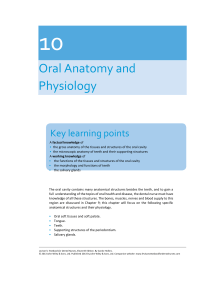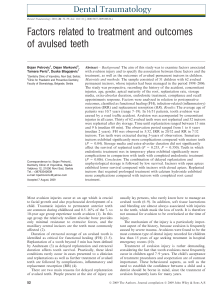Supernumerary teeth. Clinical case report
Anuncio
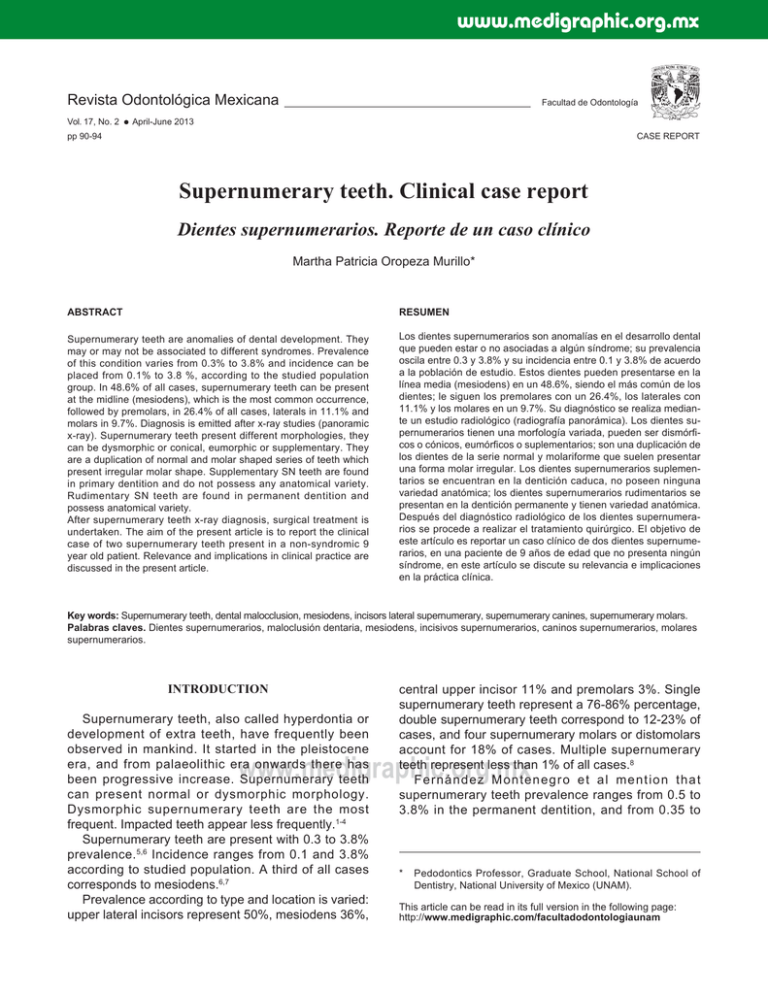
www.medigraphic.org.mx Revista Odontológica Mexicana Vol. 17, No. 2 Facultad de Odontología April-June 2013 CASE REPORT pp 90-94 Supernumerary teeth. Clinical case report Dientes supernumerarios. Reporte de un caso clínico Martha Patricia Oropeza Murillo* ABSTRACT RESUMEN Supernumerary teeth are anomalies of dental development. They may or may not be associated to different syndromes. Prevalence of this condition varies from 0.3% to 3.8% and incidence can be placed from 0.1% to 3.8 %, according to the studied population group. In 48.6% of all cases, supernumerary teeth can be present at the midline (mesiodens), which is the most common occurrence, followed by premolars, in 26.4% of all cases, laterals in 11.1% and molars in 9.7%. Diagnosis is emitted after x-ray studies (panoramic x-ray). Supernumerary teeth present different morphologies, they can be dysmorphic or conical, eumorphic or supplementary. They are a duplication of normal and molar shaped series of teeth which present irregular molar shape. Supplementary SN teeth are found in primary dentition and do not possess any anatomical variety. Rudimentary SN teeth are found in permanent dentition and possess anatomical variety. After supernumerary teeth x-ray diagnosis, surgical treatment is undertaken. The aim of the present article is to report the clinical case of two supernumerary teeth present in a non-syndromic 9 year old patient. Relevance and implications in clinical practice are discussed in the present article. Los dientes supernumerarios son anomalías en el desarrollo dental que pueden estar o no asociadas a algún síndrome; su prevalencia oscila entre 0.3 y 3.8% y su incidencia entre 0.1 y 3.8% de acuerdo a la población de estudio. Estos dientes pueden presentarse en la línea media (mesiodens) en un 48.6%, siendo el más común de los dientes; le siguen los premolares con un 26.4%, los laterales con 11.1% y los molares en un 9.7%. Su diagnóstico se realiza mediante un estudio radiológico (radiografía panorámica). Los dientes supernumerarios tienen una morfología variada, pueden ser dismórficos o cónicos, eumórficos o suplementarios; son una duplicación de los dientes de la serie normal y molariforme que suelen presentar una forma molar irregular. Los dientes supernumerarios suplementarios se encuentran en la dentición caduca, no poseen ninguna variedad anatómica; los dientes supernumerarios rudimentarios se presentan en la dentición permanente y tienen variedad anatómica. Después del diagnóstico radiológico de los dientes supernumerarios se procede a realizar el tratamiento quirúrgico. El objetivo de este artículo es reportar un caso clínico de dos dientes supernumerarios, en una paciente de 9 años de edad que no presenta ningún síndrome, en este artículo se discute su relevancia e implicaciones en la práctica clínica. Key words: Supernumerary teeth, dental malocclusion, mesiodens, incisors lateral supernumerary, supernumerary canines, supernumerary molars. Palabras claves. Dientes supernumerarios, maloclusión dentaria, mesiodens, incisivos supernumerarios, caninos supernumerarios, molares supernumerarios. INTRODUCTION Supernumerary teeth, also called hyperdontia or development of extra teeth, have frequently been observed in mankind. It started in the pleistocene era, and from palaeolithic era onwards there has been progressive increase. Supernumerary teeth can present normal or dysmorphic morphology. Dysmorphic supernumerary teeth are the most frequent. Impacted teeth appear less frequently.1-4 Supernumerary teeth are present with 0.3 to 3.8% prevalence. 5,6 Incidence ranges from 0.1 and 3.8% according to studied population. A third of all cases corresponds to mesiodens.6,7 Prevalence according to type and location is varied: upper lateral incisors represent 50%, mesiodens 36%, central upper incisor 11% and premolars 3%. Single supernumerary teeth represent a 76-86% percentage, double supernumerary teeth correspond to 12-23% of cases, and four supernumerary molars or distomolars account for 18% of cases. Multiple supernumerary teeth represent less than 1% of all cases.8 Fernández Montenegro et al mention that supernumerary teeth prevalence ranges from 0.5 to 3.8% in the permanent dentition, and from 0.35 to www.medigraphic.org.mx * Pedodontics Professor, Graduate School, National School of Dentistry, National University of Mexico (UNAM). This article can be read in its full version in the following page: http://www.medigraphic.com/facultadodontologiaunam Revista Odontológica Mexicana 2013;17 (2): 90-94 0.6% in primary dentition. The most frequently found supernumerary tooth was mesiodens (46.9%), followed by upper bicuspids (24.1%) and four supernumerary molars or distomolars (18%).9 A supernumerary tooth is an addition to the normal number of teeth, ( 20 teeth in primary dentition and 32 teeth in permanent dentition). They can appear at different stages of human development, in primary, mixed or permanent dentitions. They constitute one of the factors associated to malocclusion etiology, they elicit alteration of the midline, tooth retention, crowding, root resorption, diastema, as well as malformation of other teeth. They can be found in any region of the dental arch, and can only be observed in x-rays.1,8,9 Within the scope of etiological factors for supernumerary teeth, many of the following theories can be found: Phylogenetic theory. This is one of the earlier theories. It represents a return to the anthropoids which had a dental set up with greater number of teeth.8 Dental lamina hyperactivity theory. During the initial stage of dentition development, supernumerary teeth are probably formed as a result of dental lamina hyperactivity alterations. This is the most accepted theory.8 Dental follicle dichotomy theory. According to this theory, the follicle is divided into two equal or different parts. This leads to two similar teeth, or one similar tooth and one dysmorphic tooth.10,11 Genetic factors. Genetic heritage plays a very important role in the advent of supernumerary teeth. A dominant, autosomal, recessive gene associated to chromosome X is associated to supernumerary teeth. Its prevalence is stronger in males than in females.7,8,12,13 Supernumeray teeth are also associated to different syndromes such as: Apert 8,14 , craniofacial dysostosis or Crouzon syndrome8,14 cleidocranial dysplasia or cleidocranial dysostosis, 8,14-18 cleft lip and palate, 8,9,14,19 Down’s syndrome, 5,8,14 Gardner syndrome, 5,8,9,13-16,18-20 Hallerman-Streiff syndrome,5,8,15,17 type I and type III oral-digital-facial syndrome,5,8,15,21 leopard or multiple lentigines syndrome, 5,8,23 tricho-rhino-phalangeal syndrome, 5,8,22,23 Ellis Van Creveld syndrome, 5,8,17,23 Nance Horan syndrome,5 Kippel-Trenaunary-Weber syndrome,5 hypertrichosis syndrome,5 ZimmermannLaband syndrome,5,8 fucosidosis syndrome,5 type III Ehlers-Danlos syndrome,5 Sturge-Weber syndrome,8 91 Fabry-Anderson syndrome, 8,19 Larsen syndrome, 8 hereditary fibromatosis associated to hearing loss and supernumerary teeth.8 Morphology of supernumerary teeth in primary dentition is normal or conical. In permanent dentition morphology is diverse.7 Ballesteros, in his article mentions Yusof who encountered prevalence of premolar-shaped multiple supernumerary teeth. This differs from other reported cases of supernumerary teeth which mention predominance of mesiodens.8 Primosh classifies supernumerary teeth according to their shape in the following fashion:24 • Supplemental or eumorphic. It is a duplication of the normal dental series, the most common supplementary teeth are permanent upper lateral incisors, bicuspids and molars. This also is called «incisorformism».24 • Rudimentary or dysmorphic.24 These are teeth presenting abnormal shape or size. They are smaller-sized teeth. They can be - Conical. - Tubercular. - Molar-shaped. • Conical teeth. 24 These are small teeth located between upper central incisors, they are called mesiodens. They can be found in a high inverted position in the palate. The longitudinal axis of the tooth presents normal inclination. • Tubercular Teeth. These are larger supernumerary teeth (longer than conical teeth). They present one or more accessory cuspids, and can present full root formation. They are commonly found in the palatal area, at the level of upper central incisors.24 • Molar-shaped. They can be found at chordal level. Sendin Velasco et al reported a case with 8 third molars (four normal and four supernumerary). They can present the same shape as third molars, or they can present irregular shape. They can be found in upper and lower jaws.19,24 www.medigraphic.org.mx With respect to tooth morphology, Magallanes N . e t a l 25 c l a s s i f y s u p e r n u m e r a r y t e e t h i n t o supplementary and rudimentary. Supplementary would be those teeth which appear in primary dentition, do not possess anatomical variability and are rarely impacted. Rudimentary teeth would enjoy greater anatomical variability as well as appearing in permanent dentition. Oropeza MMP. Supernumerary teeth 92 Most frequent locations for SN teeth are: upper jaw, midline, upper palatal region of upper incisors, lower bicuspid region, and distal region with respect to the third molar, as well in the upper as in the lower jaw. In the case of multiple SN teeth, there is predilection for the lower bicuspid region, followed by molar region and anterior region.8,26 Supernumerary teeth can also be found impacted,27 inverted and impacted,27 associated to other dental anomalies,28, 29 fused to a permanent tooth as well as associated to the gemination27 of a lower central tooth. SN teeth can also be associated to taurodontism.13, 27-29 According to their location they can be classified as follows: • Mesiodens. Found between upper central incisors. They can appear as one single tooth, multiple teeth, unilateral or bilateral, erupted or impacted, vertical, horizontal, or inverted.26, 28, 30 They are frequently found in the lower jaw area. 10 Complications associated to impacted mesiodens are: delay in eruption of permanent tooth, deviation of the tooth’s eruption, retention or resorption of the permanent tooth’s root and diastema.31 • Paramolar. Small and rudimentary supernumerary molar, located in a labial (buccal) or lingual position with respect to an upper molar, or in the interproximal space found between second and third molars.32 • Distomolar. Located on the distal surface of the third molar. It is a small, rudimentary tooth which rarely prevents normal eruption of other teeth.7 In the case of supernumerary teeth, early diagnosis is paramount to avoid complications. Diagnosis can be conducted through clinical or x-ray assessment. Treatment will depend upon supernumerary tooth position and class, as well as on the effect this tooth exerts on primary or permanent dentition. Nassan 26 reported the opinion that removal of a supernumerary tooth from primary dentition is not recommended because it can cause displacement of the permanent tooth during the operation. He mentioned the fact that many primary supernumerary teeth erupted due to the presence of inter-dental spaces. Presence of supernumerary teeth which prevent eruption of permanent teeth, or deviate them from their proper position require extraction. If these are included surgical treatment is warranted. In cases where extraction or surgical treatment of supernumerary teeth is not accomplished, the following complications may result: • • • • • • • • • Retained teeth. Ectopic eruption. Dental malposition and occlusal problems. Functional problems. Interferences with orthodontic treatments. Diastema. Displacement of permanent teeth. Cysts derived from supernumerary follicles. Caries from neighboring teeth due to increase of dental plaque retention caused by the supernumerary tooth. • Rhizolysis (premature dental resorption and periodontal lesions due to compression upon roots of adjacent teeth). • Loss of tooth vitality. • Differential diagnosis with odontoma, adenomatoid tumor, cementoblastoma.31,32 CASE REPORT 9 year old female was admitted at the Pedodontics Clinic of the Graduate School, National School, of Dentistry, National University of Mexico, (UNAM). Her main complaint was dental caries. She did not present any syndrome, systemic disease or medication history. She was a cooperating patient and responded favorably to behavior management techniques. Oral clinical examination revealed normal permanent dentition with soft tissues, dental caries in the upper left second bicuspid and first molar, non-eruption of right upper central incisor and left upper cuspid presence of a semi-erupted upper left tooth with dental malformation and malposition. X-ray studies revealed presence of two supernumerary teeth in the upper arch, located at the midline. One was inverted (non-erupted) and the other presented dental malposition and malformation (semi-erupted). Both permanent central teeth were retained (Figures 1 and 2). Treatment consisted on filling (obturation) of decayed teeth and surgical extraction of SN teeth. Upon raising the flap, inverted position of right SN, as well as a shape anomaly called «enamel pearl» were observed. The left SN tooth showed irregular shape, there was retention of permanent central incisors with displacement. At a later stage, surgical extraction of supernumerary teeth was undertaken, and permanent teeth were ligated to exert traction and alignment with orthodontic treatment. The flap was then sutured. Eight days later, suture stitches were removed. Prognosis was favorable (Figures 3, 4, 5 and 6). www.medigraphic.org.mx Revista Odontológica Mexicana 2013;17 (2): 90-94 93 Este EEs ste te documento dooccumeennnto too eess eel elaborado lab abor oraaddo ppo por or M Me Medigraphic eddiiggrrap aphic hhiic Figure 1. Retention of right upper central incisor. Presence of a ill placed, irregularly shaped tooth. Figure 3. Surgical treatment, flap lifting; right and left supernumerary teeth are observed as well as retained permanent teeth. Figure 2. At maximum intercuspation point, the tooth is observed in crossbite. Figure 4. Surgical extraction of supernumerary teeth. CONCLUSIONS Dental hyperdontia (supernumerary teeth) can appear in primary and permanent dentition of children and teenagers. When dealing with supernumerary teeth etiology, the dental lamina hyperactivity theory is the most accepted, nevertheless, SN teeth have also been attributed to hereditary (genetic) patterns. These teeth are important due to their association with position, eruption and retention alterations of permanent teeth. Finding them is contingent upon a thorough and timely diagnosis that might determine their presence, root formation and location. In the present study case, treatment was performed on a 9 year old girl. In this case, genetics was a determinant factor for supernumerary teeth presence. www.medigraphic.org.mx phic.org.mx Figure 5. Permanent central incisors retained by supernumerary teeth. Oropeza MMP. Supernumerary teeth 94 Figure 6. Permanent central incisor ligated for orthodontic traction, flap suture. Absence of upper right central set the pace to determine a possible retention of the left permanent central. X-ray assessment confirmed presence of two SN teeth at the midline, which displaced and included permanent teeth. The most frequent location for SN teeth was upper jaw and midline (90-98%). SN teeth were found in the vestibular region. In the present case, observed associated complications were: eruption delay, deviation, rotation and crowding of permanent teeth. Surgical extraction was the selected treatment, since it favored traction of left and right upper centrals with the help of orthodontic devices. REFERENCES 1. García C, González O. Anomalías de la dentición, número, tamaño y forma. En: Barbería E. Odontopediatría. Barcelona: Masson; 1995: 63-65. 2. Brabant H. Palaeostomatology. En: Brothwell D, Sandison A. T. Diseases in antiquity Illinois. Springfield, Illinois: Thomas; 1967: 540-546. 3. Calatrava L, Martínez JM. En: Madrid Donado M. Cirugía bucal. Patología y técnica. Tercera Edición. Barcelona: Masson; 1990: 569-585. 4. Prieto JL, Abenza JM, Montes R, Sanguino J, Muñoz E. Hallazgos antropológicos y arqueológicos en el complejo Kárstico del Sidrón (Vallobal, Infiesto, Consejo de Piñola, Asturias). MUNIBE 2001; 53: 19-29. 5. Martínez González JG, Ortiz Orrego G. Prevalencia de dientes supernumerarios. CES Odontología 2003; 16 (1): 79-84. 6. Ponce Bravo S, Ledesma Montes C, Pérez Pérez G, Sánchez Acuña G, Morales Sánchez I, Garcés Ortiz M et al. Dientes supernumerarios en una población infantil del D.F. Estudio clínico radiográfico. Revista ADM 2004; 61 (4): 142-145. 7. Gómez Antón G, Melara Murguía AJ, Sáez Martínez S, Ballet Damau LG. Agenesias y supernumerarios: a propósito de un caso. Rev Oper Dent Endod 2008; 5: 88. 8. Blanco Ballesteros G. Dientes múltiples supernumerarios. Reporte de un caso. Revista Estomatológica 2005; 13 (1): 13-18. 9. Fernández Montenegro P, Balmaceda Castellón E, Berini Aytés L, Gay Escoda C. Estudio retrospectivo de 145 dientes supernumerarios. Med Oral Pato Oral Cir Bucal 2006; 11: 339-344. 10. Baca Pérez BR, López Carrichez C, Alobera Gracia MA, Leco Berrocal MI. Mesiodens Mandibular. Cient Dent 2007; 4 (3): 199-202. 11. Stellzing S, Basdra EK, Komposch G. Mesiodens. J Orofac Orthop 1997; 58: 144-153. 12. Chaappuzeau López E, Cortés Caballero D. Anomalías de dentición en desarrollo: agenesias y supernumerarios. Revista Dental de Chile 2008; 99 (2): 3-8. 13. Babu V, Nagesh KS, Diwakar NR. A rare case of hereditary multiple impacted normal and supernumerary teeth. J Clin Pediatr Dent 1998; 23 (1): 59-62. 14. Erdody G, López JC, Quesada D. Quiste dentígero asociado a diente supernumerario. Ciencia Odontógica 2011; 8 (1): 68-72. 15.Radi Londoño JN, Álvarez Gómez GJ. Dientes Supernumerarios: Reporte de 170 casos y revisión de la literatura. Rev Fac Odont Univ Ant 2002; 3 (2): 57-67. 16. Saap JP, Eversole LR, Wysocki GP. Patología oral y maxilofacial contemporánea. 2ª edición. Madrid: Elseiver Mosby; 2005. 17. Moret Yuli. Enfermedades genéticas que afectan la cavidad bucal. Acta Odontol Venez 2004; 42 (1) 18. Regezi JA, Sciubba JJ. Patología Bucal. 3ª edición. Nueva York: Interamericana McGraw-Hill; 1991. 19. Sendín Velasco MB, Rodríguez Achaerandio A, Cores Calvo O, Mateos García V. Cuatro molares supernumerarios a nivel de los cordales: caso clínico. Gaceta Dental Industria y Profesiones 2007; 184: 138-141. 20. Shafer WG, Tomich C, Levy MB. Tratado de Patología Bucal. Michigan; Interamericana: 1977. 21. King NM, Sanares AM. Oral-facial-digital syndrome, Type I: a case report. J Clin Pediatr Dent 2002; 26 (2): 211-215. 22. Ruz de la Cuesta M, Planelles Gomis J, Amoros Rodríguez A, Juste Ruíz M. Síndrome trico-rino-falángico. Un caso familiar. Rev Esp de Cir Ost 1985; 20: 181-187. 23. Salcido García JF, Ledesma Montes C, Hernández Flores F, Pérez D, Garcés Ortiz M. Frecuencia de dientes supernumerarios en una población Mexicana. Med Oral Patol Oral Cir Bucal 2004; 9 (5): 403-409. 24. Primosch R. Anterior supernumerary teeth assessment and surgical intervention in children. Pediatr Dent 1981; 3: 204-215. 25. Magallanes Abad N, Torres Lagares D, Gutiérrez Pérez JL. Exodoncia de los mesiodens que impiden la erupción de los dos incisivos centrales superiores. Rev Secib On Line 2006; 4: 26-35. 26. Ersin NK, Candan U, Alpoz AR, Akay C. Mesiodens in primary, mixed and permanent dentition a clinical and radiographic study. J Clin Pediatr 2004; 28 (4): 295-298. 27. Atasu M, Orguneser A. Inverted impaction of a mesiodens: a case report. J Clin Pediatr Dent 1999; 23 (2): 143-146. 28. Atasu M, Cimilli H. Fusion of the permanent maxillary right incisor to a supernumerary tooth in association with a germination of permanent maxillary left central incisor: a dental, genetic and dermatoglyphic study. J Clin Pediatr Dent 2000; 24 (4): 321-333. 29. Genc A, Namdar F, Goker K, Atasu M. Taurodontism in association with supernumerary teeth. J Clin Pediatr Dent 1999; 23 (2): 151-154. 30. Chevitarese AB, Tavares CM, Primo L. Clinical complications associated with supernumerary teeth: report of two cases. J Clin Pediatr Dent 2003; 28 (1): 27-32. 31. Gallas MM, García A. Case study: retention of permanent incisors by mesiodens: a family affair. Br Dent J 2000; 188: 63-64. 32. Contreras Somoza MF, Salinas Noyola A, Sáez Martínez S, Sellet LG. Signos de dientes supernumerarios. Rev Op Dent Endod 2007; 5 (60): 210. www.medigraphic.org.mx Mailing address: Martha Patricia Oropeza Murillo E-mail: [email protected]
